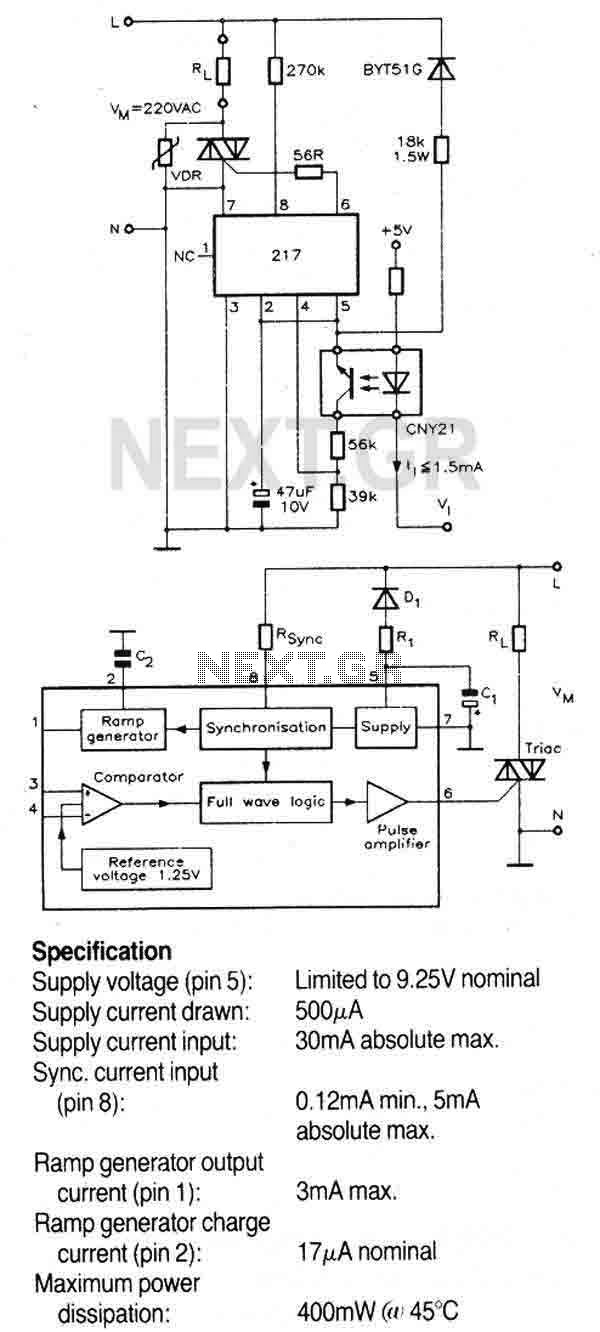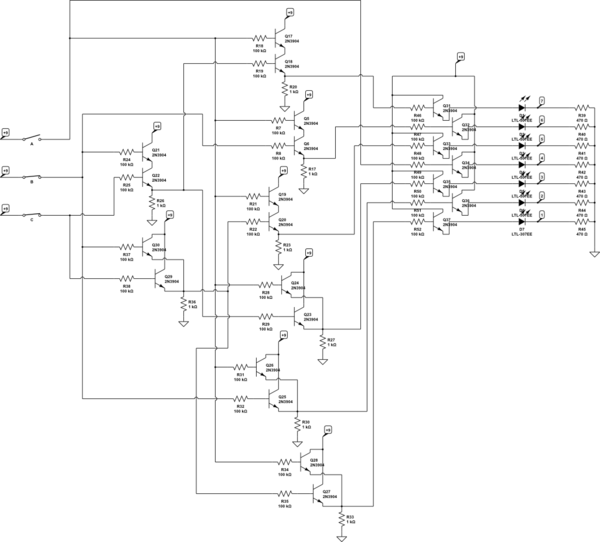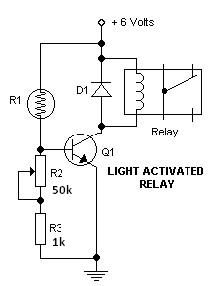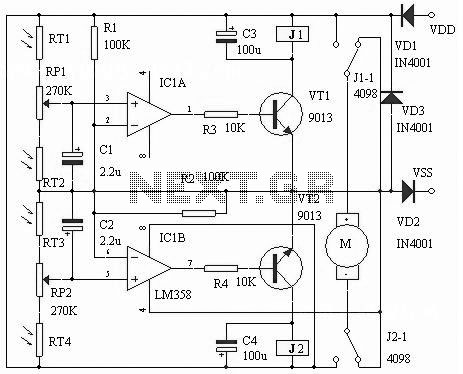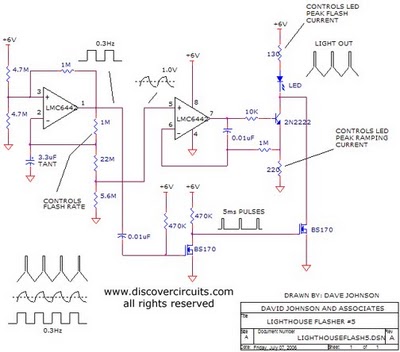
Traffic Light Controller

This is a simple traffic light controller that can be used to teach children the basics of traffic light rules. The circuit employs commonly available electronic components and consists of rectifier diodes (1N4001), a 5V regulator (7805), two timer circuits using IC 555, two relays (5V, single changeover), and three 15W, 230V light bulbs, along with several discrete parts. The mains electrical power is reduced in voltage by transformer X1 to provide a secondary output of 9V, 300 mA AC. The output current from the transformer is rectified by a full-wave bridge rectifier made up of diodes D1 through D4, filtered by capacitor C1, and regulated by IC 7805 (IC1). IC2 is configured as a multivibrator with on and off periods of approximately 30 seconds each, determined by the component values. When the mains power switch is turned on, pin 3 of IC2 goes high for 30 seconds, energizing relay RL1 via transistor T1, causing the red bulb (B1) to illuminate through its normally-open (N/O) contact. Simultaneously, mains power is disconnected from the pole of relay RL2. At the end of the on time of IC2, a trigger is sent to IC3 through capacitor C5. IC3 is set up as a monostable circuit with an on time of about 4 seconds, keeping pin 3 of IC3 high for this duration, which energizes relay RL2 through driver transistor T2. Consequently, the amber bulb (B2) lights up for 4 seconds. Following the 4-second period of timer IC3, relay RL2 de-energizes, and the green bulb (B3) illuminates for the remaining off period of IC2, approximately 26 seconds. Thus, when the mains electrical switch is activated, the red light shines for 30 seconds, the amber for 4 seconds, and the green for 26 seconds. This circuit can be easily constructed on a general-purpose PCB and enclosed in a protective box. The box should provide adequate space for the transformer X1 and the two relays. It can be positioned near a 230V AC, 50Hz power supply or mounted on a PVC tube used in the assembly of the traffic light box. A sturdy cardboard box measuring 30x15x10 cm is required to house the lights. For durability, a 10x45 cm plywood plate with a thickness of 1.5 centimeters should be used to secure the three light outlets and the box with nuts and bolts or screws. Three tubes made from thin aluminum sheets, available at hardware stores, should be created. The inner diameter of these aluminum tubes must be compatible with the light outlets. Using a sharp knife, carefully make holes opposite the outlets. Wire the outlets at the back and guide the cables out through the PVC tube. Start by fixing three 15W light bulbs (B1 to B3) and then insert the tubes. Support the other ends of the tubes in the holes drilled on the front panel of the cardboard box. Sandwich colored gelatine papers between two sheets of cardboard and secure them over the tubes. The visibility of the red, amber, and green lights is enhanced by their installation in a tubular shape.
The traffic light controller circuit is designed to simulate the operation of real traffic lights, providing a practical learning tool for children. The use of IC 555 timers allows for precise control of the timing intervals for each light, ensuring that the sequence accurately reflects real-world traffic light operations. The inclusion of relays enables the high-voltage light bulbs to be controlled safely, isolating low-voltage control circuitry from high-voltage components.
The design also emphasizes safety and durability, particularly in the enclosure and mounting of components. The use of a plywood plate for mounting ensures stability, while the aluminum tubes provide a robust structure for the light bulbs. The gelatine papers used to filter the light add an aesthetic element while serving the functional purpose of color differentiation.
Overall, this circuit not only serves as an educational tool but also provides insights into basic electronic principles, including power regulation, timing circuits, and relay operation. It can be an effective project for hobbyists and educators looking to introduce fundamental electronics and safety concepts to young learners.Here the simple traffic light controller which is could be used to educate kids rudiments of traffic light guidelines. The circuit utilizes easily available electronic parts. It generally consists of rectifier diodes (1N4001), a 5V regulator 7805, two timers circuit using IC 555, two relays (5V, single-changeover), three 15W, 230V light bulbs and
also several discrete parts. Mains electrical power is stepped down by transformer X1 to provide a secondary output voltage of 9V, 300 mA AC. Then the transformer output current is rectified by a full-wave bridge rectifier composed of diodes D1 through D4, filtered by capacitor C1 and also regulated by IC 7805 (IC1).
IC2 is wired as a multivibrator with on` and off` periods of about 30 seconds each with the part values determined. Once mains power switch is turned on, pin 3 of IC2 goes high for 30 seconds. This, in turn, energises relay RL1 via transistor T1 and the red bulb (B1) glows through its normally-open (N/O) contact.
At the same time, mains power is turned off from the pole of relay RL2. As the on` time of IC2 ends, a triggers IC3 through C5. IC3 is set up as a monostable with on` time of about 4 seconds, which indicates pin 3 of IC3 will stay high for this period of time and energise relay RL2 through driver transistor T2. The amber bulb (B2) thus lightings up for 4 seconds. Immediately after 4-second time period of timer IC3 at pin 3 lapses, relay RL2 de-energises and also the green bulb (B3) lights up for the rest of off` period of IC2, which is about 26 seconds.
The green bulb is turned on through the normally closed (N/C) contacts of relay RL2. So when mains electrical switch is turned on, red light will light up for 30 seconds, amber for 4 seconds and green for 26 seconds. You can easily build this circuit on a general purpose PCB and enclose in a protected box. The box needs to have sufficient area for installing transformer X1 and also two relays. It could be installed near 230V AC, 50Hz power supply or mounted on the PVC tube applied in assembly of the traffic light box.
A stout cardboard box of 30x15x10cm3 is needed for housing the lights. To make certain durability, work with a 10x45cm2 plywood plate having 1. 5 centimeters thickness and also secure onto it three light outlets and the box utilizing nuts and bolts or screws. Make three tubes of thin aluminium sheet, which is easily offered in equipment stores. The inner diameter of aluminium tubes ought to be such that these can well match on the light outlets.
Working with a sharp knife, make holes opposite the outlets carefully. Wire the outlets at the back and take the cables out through the PVC tube. To begin with, fix three 15W light bulbs (B1 through B3) and then press on the tubes. Support the other ends of the tubes in the holes made on the front panel of cardboard box. Sandwich gelatine papers of the three colors in between two sheets of cardboard and fix over the tubes. The visibility of red, amber and also green lights enhances with their installation on the tubular shape.
🔗 External reference
The traffic light controller circuit is designed to simulate the operation of real traffic lights, providing a practical learning tool for children. The use of IC 555 timers allows for precise control of the timing intervals for each light, ensuring that the sequence accurately reflects real-world traffic light operations. The inclusion of relays enables the high-voltage light bulbs to be controlled safely, isolating low-voltage control circuitry from high-voltage components.
The design also emphasizes safety and durability, particularly in the enclosure and mounting of components. The use of a plywood plate for mounting ensures stability, while the aluminum tubes provide a robust structure for the light bulbs. The gelatine papers used to filter the light add an aesthetic element while serving the functional purpose of color differentiation.
Overall, this circuit not only serves as an educational tool but also provides insights into basic electronic principles, including power regulation, timing circuits, and relay operation. It can be an effective project for hobbyists and educators looking to introduce fundamental electronics and safety concepts to young learners.Here the simple traffic light controller which is could be used to educate kids rudiments of traffic light guidelines. The circuit utilizes easily available electronic parts. It generally consists of rectifier diodes (1N4001), a 5V regulator 7805, two timers circuit using IC 555, two relays (5V, single-changeover), three 15W, 230V light bulbs and
also several discrete parts. Mains electrical power is stepped down by transformer X1 to provide a secondary output voltage of 9V, 300 mA AC. Then the transformer output current is rectified by a full-wave bridge rectifier composed of diodes D1 through D4, filtered by capacitor C1 and also regulated by IC 7805 (IC1).
IC2 is wired as a multivibrator with on` and off` periods of about 30 seconds each with the part values determined. Once mains power switch is turned on, pin 3 of IC2 goes high for 30 seconds. This, in turn, energises relay RL1 via transistor T1 and the red bulb (B1) glows through its normally-open (N/O) contact.
At the same time, mains power is turned off from the pole of relay RL2. As the on` time of IC2 ends, a triggers IC3 through C5. IC3 is set up as a monostable with on` time of about 4 seconds, which indicates pin 3 of IC3 will stay high for this period of time and energise relay RL2 through driver transistor T2. The amber bulb (B2) thus lightings up for 4 seconds. Immediately after 4-second time period of timer IC3 at pin 3 lapses, relay RL2 de-energises and also the green bulb (B3) lights up for the rest of off` period of IC2, which is about 26 seconds.
The green bulb is turned on through the normally closed (N/C) contacts of relay RL2. So when mains electrical switch is turned on, red light will light up for 30 seconds, amber for 4 seconds and green for 26 seconds. You can easily build this circuit on a general purpose PCB and enclose in a protected box. The box needs to have sufficient area for installing transformer X1 and also two relays. It could be installed near 230V AC, 50Hz power supply or mounted on the PVC tube applied in assembly of the traffic light box.
A stout cardboard box of 30x15x10cm3 is needed for housing the lights. To make certain durability, work with a 10x45cm2 plywood plate having 1. 5 centimeters thickness and also secure onto it three light outlets and the box utilizing nuts and bolts or screws. Make three tubes of thin aluminium sheet, which is easily offered in equipment stores. The inner diameter of aluminium tubes ought to be such that these can well match on the light outlets.
Working with a sharp knife, make holes opposite the outlets carefully. Wire the outlets at the back and take the cables out through the PVC tube. To begin with, fix three 15W light bulbs (B1 through B3) and then press on the tubes. Support the other ends of the tubes in the holes made on the front panel of cardboard box. Sandwich gelatine papers of the three colors in between two sheets of cardboard and fix over the tubes. The visibility of red, amber and also green lights enhances with their installation on the tubular shape.
🔗 External reference
